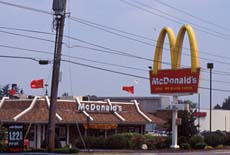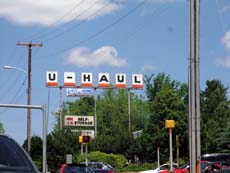Repetition: franchises
Franchised places are not all parts of one big place. We don't expect the trajectories of a single action to involve multiple McDonald's restaurants. Yet those restaurants are more than buildings that just happen to resemble one another. The franchises are built to follow a formula. Their similarity is controlled. If I built a duplicate McDonald's but had no relation with the company, I'd be in big legal trouble. So the repetition is a social fact. They are controlled by a normative relation to a rule.
As franchises become more common along commercial strips, local places begin to resemble each other more. The strip opens a list of familiar places. Local color becomes restricted to the odd small store or hold-out retailer (or perhaps the local boutiques that try to survive in a downtown that daily life retail has abandoned).
Franchises have a history, but it is not relevant to the consumer. The original hamburger stands built by the McDonald brothers in California no longer exist. It doesn't matter whether or not current restaurants look like the originals or serve the same menu. If historians discovered that the McDonald brothers had never really been associated with those original restaurants, or that the restaurants had really been latte bars, that would not affect the legitimacy of the current restaurants. McDonald's franchises do not get their authenticity from any relation to a privileged original, but from faithfulness to a rule.
Residences and suburban developments can also be franchised. There are similar Sun City retirement developments in different warm-weather regions; sharing a general layout and the prestige of the brand. Extending this idea by imagining a future world-wide franchise system of identical gated suburban enclaves ("burbclaves"), Neal Stephenson writes of such a franchise chain: "The Mews at Windsor Heights all have the same layout. When creating a new Burbclave, TMAWH Development Corporation will chop down any mountain ranges and divert any mighty rivers that threaten to interrupt this street plan -- ergonomically designed to encourage driving safety. A [pizza delivery driver] can go into a Mews at Windsor Heights anywhere from Fairbanks to Yaroslavl to the Shenzhen special economic zone and find his way around" (Stephenson 1993, 12). Stephenson also imagines "Mr. Lee's Hong Kong," which is "a private, wholly extraterritorial, sovereign, quasi-national entity" that consists solely of a set of franchises (Stephenson 1993, 83, 98-99). Like McDonald's, Mr. Lee's consists of separated locales with no relation to a privileged origin. Unlike McDonald's it asserts its unity as one dispersed place.

